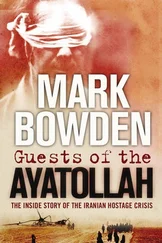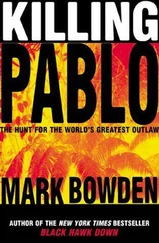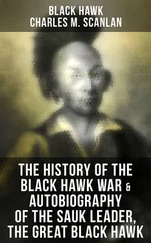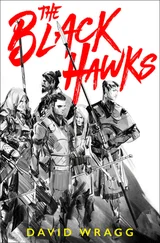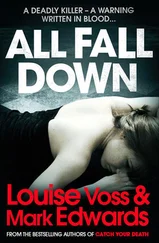Mark Bowden - Black Hawk Down
Здесь есть возможность читать онлайн «Mark Bowden - Black Hawk Down» весь текст электронной книги совершенно бесплатно (целиком полную версию без сокращений). В некоторых случаях можно слушать аудио, скачать через торрент в формате fb2 и присутствует краткое содержание. Город: New York, Год выпуска: 1999, ISBN: 1999, Издательство: Atlantic Monthly Press, Жанр: nonf_military, на английском языке. Описание произведения, (предисловие) а так же отзывы посетителей доступны на портале библиотеки ЛибКат.
- Название:Black Hawk Down
- Автор:
- Издательство:Atlantic Monthly Press
- Жанр:
- Год:1999
- Город:New York
- ISBN:978-0871137388
- Рейтинг книги:3 / 5. Голосов: 1
-
Избранное:Добавить в избранное
- Отзывы:
-
Ваша оценка:
- 60
- 1
- 2
- 3
- 4
- 5
Black Hawk Down: краткое содержание, описание и аннотация
Предлагаем к чтению аннотацию, описание, краткое содержание или предисловие (зависит от того, что написал сам автор книги «Black Hawk Down»). Если вы не нашли необходимую информацию о книге — напишите в комментариях, мы постараемся отыскать её.
Black Hawk Down — читать онлайн бесплатно полную книгу (весь текст) целиком
Ниже представлен текст книги, разбитый по страницам. Система сохранения места последней прочитанной страницы, позволяет с удобством читать онлайн бесплатно книгу «Black Hawk Down», без необходимости каждый раз заново искать на чём Вы остановились. Поставьте закладку, и сможете в любой момент перейти на страницу, на которой закончили чтение.
Интервал:
Закладка:
He folded the muscle tissue back into the wound, packed some gauze into it, and applied a pressure dressing. Then he crawled back out into the alley, finding cover in a small, cup-shaped space behind the main body of the helicopter created by its bent tail boom.
Fales’ wound heightened Wilkinson’s sense of urgency. He had thought they would have a few minutes to set up before coming under attack. In past missions, it had usually taken 10 to 20 minutes for a Somalian crowd to gather around any action on the streets. But now they had to mount their rescue under immediate heavy fire.
Wilkinson assumed Lt. Col. Danny McKnight’s ground convoy would be pulling up at any minute; he had no way of knowing that the convoy was hopelessly lost and getting hammered. He and his team would need to get the wounded and dead out of the helicopter, treat the wounded, and have the men on litters by the time the vehicles approached. But he hadn’t even been inside the helicopter yet, and now his rescue team leader was wounded.
Wilkinson moved quickly to the front of the helicopter. A Commando soldier, Sgt. James McMahon, who was aboard Wolcott’s Super 61 when it crashed, was already on top of the bird, pulling out copilot Donovan “Bull” Briley. McMahon’s face was badly cut and swollen from the impact of the crash. It was purple and black. He looked as if he were wearing a fright mask.
Briley was obviously dead. On impact something had sliced through his head, angling up from just under his chin. His body was relatively easy to reach because he was strapped in the right seat, which was now on the high side. Wilkinson helped McMahon pull Briley up and out, and then handed his body down to two sergeants. They carried him over to the designated casualty collection point, the protected space where Fales had crawled.
McMahon climbed down into the cockpit and checked on pilot Cliff “Elvis” Wolcott.
“He’s dead,” he told Wilkinson.
Since McMahon was not a medic, Wilkinson felt the need to see for himself. He told McMahon to get some medical attention for his face, and then he climbed up into the bird.
It was eerily quiet inside. There had been no fire, and there was no smoke. Everything inside that hadn’t been strapped down had been violently thrown around and had come to rest on the left side, which was now the bottom. There was a slight odor of fuel inside, where various liquids were draining down. He dipped his finger in the fluid and sniffed. It wasn’t fuel.
Wilkinson was suspended upside down as he reached in and felt Wolcott’s carotid artery for a pulse. He was dead. He and Briley had taken the brunt of the impact, and Wolcott, because his side had hit the ground, had gotten the worst of it. The whole front end of the helicopter had folded in on him from the waist down. He was still in his seat, and his head and upper torso were intact, but the nose and instrument panel and crumpled front end of the aircraft had collapsed into his lap.
Now the rescue team had to figure out a way to cut Elvis out of there. They were not leaving without him. They would not consider it. They did not leave their dead on the battlefield.
Wilkinson tried to slide his hand to grab the pilot’s legs, but there wasn’t space. He could not be lifted or pulled free. Wilkinson then slid completely into the helicopter and crawled back behind the pilot’s seat to see if Elvis could be pulled back and out that way, but that vantage looked no better.
He climbed out and got down on the dirt by the smashed left underside of the cockpit, digging to see if there was a way to create an opening underneath the wreck so that Elvis’ body could be extracted. But the Blackhawk had plowed hard into the soil. There would be no easy way to get the body out.
CHAPTER 18
Rescue Team Comes Under Fierce Fire
December 3, 1997
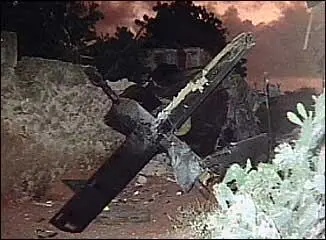
Sgt. TIM WILKINSON climbed back into the wrecked helicopter to see whether he could get more leverage to free the body of pilot Cliff Wolcott. Perhaps there was some way he hadn’t seen at first to pull the pilot seat back and get more room and a better angle. But after a while he saw that it was hopeless.
He crawled out of the cockpit of Blackhawk Super 61, and, kneeling on top of it, he peered through the open right side doors into the main cargo area. They had accounted for the pilots—both dead—and one of the crew chiefs, who was injured. Wilkinson knew some of the guys from Super 61 had been rescued by a Little Bird that had landed and loaded up survivors.
He thought everyone was out of the wreck, so now he was looking for any sensitive equipment, weapons or papers to be removed. As a member of a highly trained rescue team, he had been taught to quickly erase the memory banks of any electronic equipment that held important data. In this case, he didn’t want Somalis taking classified stuff once Wolcott’s body was recovered and the Americans had pulled out.
All the avionics equipment and every piece of gear that hadn’t been strapped down had come to rest at the left side of the aircraft, which was now the bottom. In the heap Wilkinson noticed a scrap of desert battle dress uniform.
“There’s somebody else in there,” he told Sgt. First Class Bob Mabry, a Commando medic standing alongside the wreck.
Wilkinson leaned in farther and saw an arm and a flight glove. He called down into the wreck, and a finger of the flight glove moved. Wilkinson climbed back into the wreckage and began pulling the debris and equipment off the man buried there.
It was the left side gunner, Staff Sgt. Ray Dowdy. He was still in his seat. Part of the seat had been snapped off its hinges, but it was basically intact and in place.
When Wilkinson freed Dowdy’s arm from under the pile, the crew chief was sufficiently alert to start helping to shove things away. Dowdy still hadn’t spoken and was clearly dazed and disoriented. The last thing he remembered was noticing he didn’t have his seat belt fastened before hitting the ground.
Wilkinson was throwing things off and prying things back. He reached in to help Dowdy pull free of the seat. Mabry crawled down under the wreck and tried without success to make his way in through the bottom right-side doorway to reach Dowdy from below. He gave up and climbed in through the upper doors just as Wilkinson freed Dowdy.
The three men were standing inside the wreck when a storm of bullets tore through the skin of the craft. Mabry and Wilkinson danced involuntarily, hopping away from the sharp burst of snapping and crashing noises. Dowdy saw the tips of two fingers shot off, just the tip of his index finger and about half the first digit of his middle finger. He felt no pain and said nothing. Bits and pieces of debris were flying around them. To Wilkinson it looked like a sudden snowstorm. Then it stopped.
Wilkinson remembers noting, first, that he was still alive. Then he checked himself. He’d been hit in the face and arm. It felt as if he’d been slapped or punched in the chin. Everyone had been hit. Mabry had been hit in the hand. Wilkinson looked at Dowdy. The crew chief’s eyes were open wide, with a blank look. He was staring at his bloody hand.
Wilkinson put his hand over Dowdy’s bleeding fingertip and said: “OK, let’s get out of here!”
Mabry tore up the bullet-resistant floor panels and propped them up over the side of the craft where the bullets had burst through. To avoid the gunfire outside, Mabry and Wilkinson tunneled out of the aircraft, digging wider a hole where the rear corner of the left side door was above ground. They slid Dowdy out that way.
Then the two medics went back inside for a few more minutes, searching for more equipment to destroy. Mabry set to work handing out the bullet-resistant panels from the interior, which were being placed around the tail of the aircraft where a wounded sergeant, Scott Fales, had established a casualty collection point.
Читать дальшеИнтервал:
Закладка:
Похожие книги на «Black Hawk Down»
Представляем Вашему вниманию похожие книги на «Black Hawk Down» списком для выбора. Мы отобрали схожую по названию и смыслу литературу в надежде предоставить читателям больше вариантов отыскать новые, интересные, ещё непрочитанные произведения.
Обсуждение, отзывы о книге «Black Hawk Down» и просто собственные мнения читателей. Оставьте ваши комментарии, напишите, что Вы думаете о произведении, его смысле или главных героях. Укажите что конкретно понравилось, а что нет, и почему Вы так считаете.






